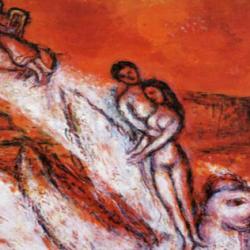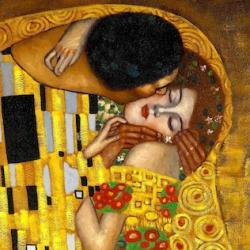The opening statement of Song of Songs 2 is spoken by the Bride, but the Bridegroom chimes in with an enhancement. This is the liturgical structure of conversation, and of life, and of love. When Adam named the animals, he found no one to share in His priestly task in the garden-sanctuary of God. He is not looking first of all for a sexual partner, or even a friend, but for a liturgical partner. He needs someone who will speak back to his word. Eve is created to speak back to Adam the enhancing, glorifying word of the bride, as humanity, the Bride of God, speaks back to her divine Husband. As James Jordan says, women were created to talk back to men, and that back-talk is primarily liturgical, though the liturgy finally encompasses all of life.
This is the structure of the Psalms and Proverbs.
In many Psalms, the verses are two lines long; the first states something or exclaims a praise to God, and the second is the enhancing, glorifying response. The second line “parallels” the first, but it is not merely a restatement. It is the glorifying, feminine response to the masculine statement of the first line. “Bless the Lord, O my soul” says the priest; “And all that is within me, bless His holy name,” comes the Bridal reply. That dialogic structure is inherent in much of the church’s liturgical tradition.
What is intriguing in the Song, however, is that this liturgical structure is inverted in the opening exchange. The Bride speaks first, and the Bridegroom responds to her overtures and desires. The declaration of 2:1, “I am the rose of Sharon, the lily of the valleys” is the Bride’s declaration about herself. Dodi responds to her declaration by agreeing with her that she is a lily and then by adding that she is so incomparably a lily that the maidens are to her a thorn bush. Eve speaks first in the Son, and Adam follows her lead. Eve was created to talk back to Adam; but, as Paul says, the sexes exist in mutual dependence, and so it seems to be the case that Adam is created to talk back to Eve.
This at least qualifies our understanding of sex roles in the Bible, and it is not the only case where this happens. Rebekah, Tamar, Ruth, Esther, and others are feminine initiators, who make the first move to unravel the traps that their men have made for themselves. Feminine initiation is different from masculine, but it is still initiation.
The inversion has intriguing consequences for liturgical theology and order. If the Song is, as we have said, typologically a love song of Christ and the church, then the Bride’s initiation points to the initiation of the church in the dialog with her Lord. Christ is the head, yet Christ not only speaks to a responsive Bride but responds to a speaking Bride.
How can we make theological sense of this? Pneumatology helps. Revelation ends with the cry of the “Spirit and the Bride” who call on Jesus to come quickly. In the larger scheme, this is a responsive cry, since it is a plea for the Son to keep His promise to come. But in the particular moment, it is a cry initiated by the Bride, but the Bride filled with and speaking with the Spirit. The Spirit catches up the Bride in His own groaning to the Son and the Father. The Spirit catches the Bride up into the interTrinitarian communication because He catches the bride into the interTrinitarian communion.
Our Bridal initiatives in the liturgy are likewise inspired by the Spirit. We initiate speech to Jesus, and He speaks back. We claim we are roses and lilies, and He agrees. But those declarations come from the Spirit and the Bride, not the Bride alone.











